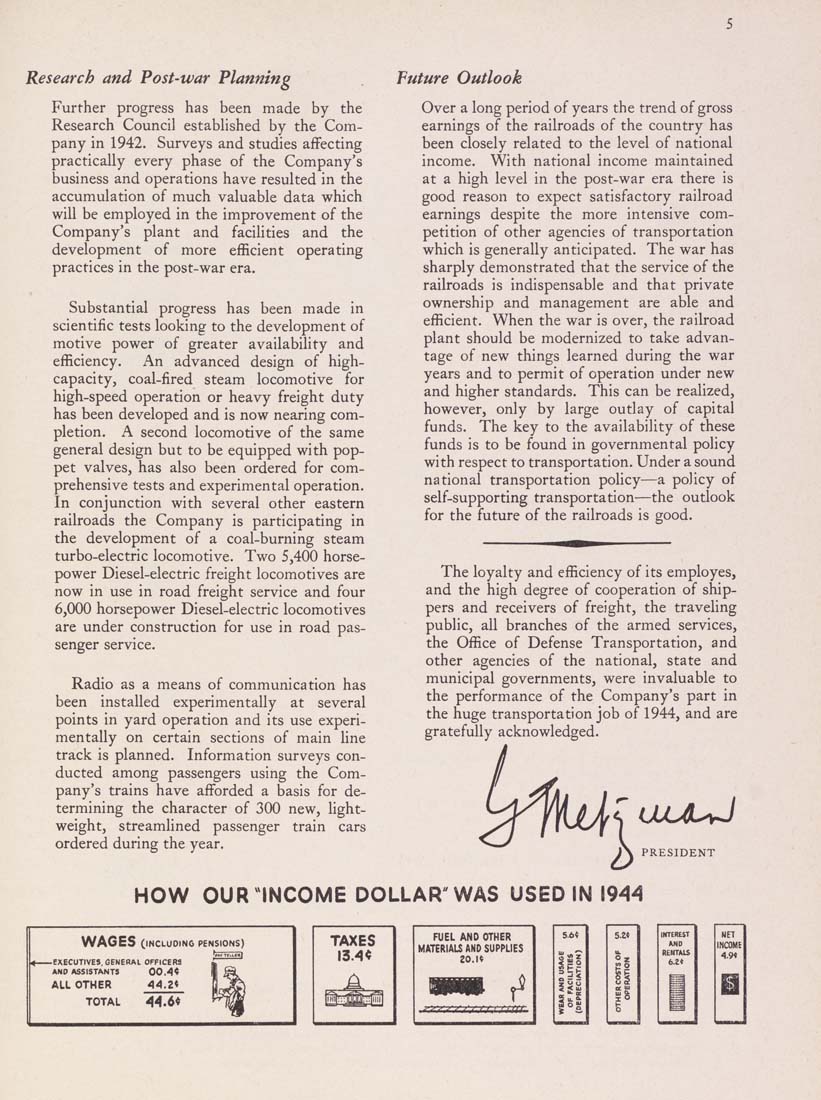Research and Post-war Planning
Further progress has been made by the
Research Council established by the Com¬
pany in 1942. Surveys and studies affecting
practically every phase of the Company's
business and operations have resulted in the
accumulation of much valuable data which
will be employed in the improvement of the
Company's plant and facihties and the
development of more efficient operating
practices in the post-war era.
Substantial progress has been made in
scientific tests looking to the development of
motive power of greater availability and
efficiency. An advanced design of high-
capacity, coal-fired steam locomotive for
high-speed operation or heavy freight duty
has been developed and is now nearing com¬
pletion. A second locomotive of the same
general design but to be equipped with pop¬
pet valves, has also been ordered for com¬
prehensive tests and experimental operation.
In conjunction with several other eastern
railroads the Company is participating in
the development of a coal-burning steam
turbo-electric locomotive. Two 5,400 horse¬
power Diesel-electric freight locomotives are
now in use in road freight service and four
6,000 horsepower Diesel-electric locomotives
are under construction for use in road pas¬
senger service.
Radio as a means of communication has
been installed experimentally at several
points in yard operation and its use experi¬
mentally on certain sections of main line
track is planned. Information surveys con¬
ducted among passengers using the Com¬
pany's trains have afforded a basis for de¬
termining the character of 300 new, hght-
weight, streamlined passenger train cars
ordered during the year.
Future Outlook
Over a long period of years the trend of gross
earnings of the railroads of the country has
been closely related to the level of national
income. With national income maintained
at a high level in the post-war era there is
good reason to expect satisfactory railroad
earnings despite the more intensive com¬
petition of other agencies of transportation
which is generally anticipated. The war has
sharply demonstrated that the service of the
railroads is indispensable and that private
ownership and management are able and
efficient. When the war is over, the railroad
plant should be modernized to take advan¬
tage of new things learned during the war
years and to permit of operation under new
and higher standards. This can be realized,
however, only by large outlay of capital
funds. The key to the availability of these
funds is to be found in governmental policy
with respect to transportation. Under a sound
national transportation policy—a policy of
self-supporting transportation—the outlook
for the future of the railroads is good.
The loyalty and efficiency of its employes,
and the high degree of cooperation of ship¬
pers and receivers of freight, the travehng
public, all branches of the armed services,
the Office of Defense Transportation, and
other agencies of the national, state and
municipal governments, were invaluable to
the performance of the Company's part in
the huge transportation job of 1944, and are
gratefully acknowledged.
< UjUuJ
PRESIDENT
HOW OUR INCOME DOLLAR" WAS USED IN 1944
WAGES (INCLUDING PENSIONS)
-EXECUTIVES, GENERAL OFFICERS
ANO ASSISTANTS 00.A<
ALL OTHER 44.2*
TOTAL
AA,6i
FUEL AND OTHER
MATERIALS AND SUPPLIES
20.l«
r^
■y^j-^r^T^^-rrfr
5.6«
5.2«
INTEREST
AND
NET
INCOME
EAR ANO USAGE
OF FACILITIES
EPRECIATION)
HERCOSTSOF
OPERATION
REHTALS
6.2*
4.9«
* s.
o
|








